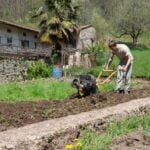How often do you water vegetable gardens? Proper watering is crucial for the success of your vegetable garden. Understanding the water needs of different vegetables, factors to consider when determining watering frequency, signs of overwatering and underwatering, and best practices for watering are all essential elements in maintaining a healthy garden.
Conserving water and creating a watering schedule are also important aspects to consider. In this article, we will discuss the importance of proper watering for vegetable gardens and provide tips on how to effectively manage the water requirements of your plants.
When it comes to the importance of proper watering for vegetable gardens, it cannot be overstated. Water is essential for plant growth and development. Without an adequate supply of water, your vegetables may not thrive or produce as desired. Understanding the specific water needs of different vegetables is key to ensuring that they receive the appropriate amount of moisture.
In addition to understanding the water needs of your plants, there are several factors to consider when determining watering frequency. These include soil type, weather conditions, and the stage of growth your vegetables are in.
It’s also important to be aware of signs of overwatering and underwatering in your vegetable garden, as both can have detrimental effects on plant health. By following best practices for watering and implementing different watering methods, you can ensure that your vegetable garden receives the right amount of moisture while conserving water at the same time.
Understanding the Water Needs of Different Vegetables
When it comes to watering your vegetable garden, it’s essential to understand the specific water needs of the different types of vegetables you are growing. Not all vegetables require the same amount of water, and overwatering or underwatering can have significant impacts on their growth and yield.
For example, leafy greens such as lettuce and spinach require more frequent watering because they have shallow root systems and wilt quickly in hot, dry conditions. On the other hand, vegetables like tomatoes and peppers have deeper roots and can tolerate slightly drier soil.
Another factor to consider is the stage of growth that your vegetables are in. Newly planted seeds or transplants need consistent moisture to establish roots, while mature plants may need less frequent but deeper watering to encourage strong root development.
In addition to understanding the specific water needs of different vegetables, it’s also important to take into account external factors such as temperature, humidity, and soil type. Sandy soils drain more quickly and may require more frequent watering, while clay soils retain moisture longer and may need less frequent watering. Keeping these factors in mind will help you determine the best watering schedule for your vegetable garden.
| Vegetable | Water Needs |
|---|---|
| Lettuce | Frequent watering due to shallow roots |
| Tomatoes | Deeper but less frequent watering |
| Potatoes | Consistent moisture during tuber formation |
Factors to Consider When Determining Watering Frequency
When it comes to watering your vegetable garden, there are several factors to consider in order to determine the proper frequency. One of the most important factors is the type of soil in your garden. Sandy soil drains faster and may require more frequent watering, while clay soil retains moisture for longer periods of time. Understanding the composition of your soil can help you make informed decisions about how often to water your vegetables.
Another factor to consider is the weather and climate in your area. During hot and dry periods, your vegetable garden will likely require more frequent watering compared to cooler and wetter seasons. It’s also important to take into account the specific water needs of the vegetables you are growing. Some plants may thrive in drier conditions, while others may require more consistent moisture.
The size and age of your vegetable plants are also important considerations. Young seedlings typically need more frequent watering compared to established plants with deeper root systems. Additionally, larger plants with dense foliage may shade the soil, reducing evaporation and thus requiring less frequent watering.
| Factors to Consider | Considerations |
|---|---|
| Soil Type | Sandy soil drains faster; clay soil retains moisture |
| Weather/Climate | Hot/dry weather requires more frequent watering; cooler/wetter seasons require less |
| Vegetable Water Needs | Different vegetables have varying water requirements |
| Plant Size/Age | Youthful plants usually need more water; older ones with deep roots need less |
Signs of Overwatering and Underwatering in Vegetable Gardens
Properly watering your vegetable garden is crucial for the health and growth of your plants. Overwatering can lead to root rot, nutrient leaching, and ultimately the death of your vegetables. On the other hand, underwatering can cause wilting, stunted growth, and poor fruit development. It’s essential to be able to recognize the signs of overwatering and underwatering in order to adjust your watering practices accordingly.
One common sign of overwatering in vegetable gardens is yellowing or browning of the leaves. This occurs because when the soil is waterlogged, it restricts oxygen flow to the plant’s roots, causing them to suffocate and die. Other signs include mold or fungus growth on the soil surface and a foul odor coming from the soil.
In contrast, underwatered plants will have wilted leaves that may also turn yellow or brown. The soil will be dry to the touch and may pull away from the edges of the pot or garden bed.
To prevent overwatering or underwatering your vegetable garden, it’s important to understand the water needs of each type of vegetable you are growing. Some vegetables like tomatoes and cucumbers require more water, while others like peppers and onions require less.
Additionally, consider factors such as temperature, humidity, soil type, and stage of plant development when determining how often to water your vegetable garden. By paying attention to these signs and understanding plant needs, you can ensure that your vegetable garden receives just the right amount of water for optimal growth and productivity.
Implementing best practices for watering your vegetable garden is key in avoiding both overwatering and underwatering. These practices include watering deeply but infrequently to encourage deep root growth, using mulch to retain moisture in the soil, watering at optimal times during the day (early morning or late afternoon), and being mindful of how much water you’re applying each time.
By being attentive to these signs and following best practices for watering, you can maintain a healthy vegetable garden all season long.
Best Practices for Watering Vegetable Gardens
Proper watering is essential for the health and success of your vegetable garden. Without adequate water, plants can wilt, become stressed, and produce fewer fruits and vegetables. On the other hand, overwatering can lead to root rot and other fungal diseases. Here are some best practices to ensure that your vegetable garden receives the right amount of water.
Watering in the Morning
One of the best practices for watering your vegetable garden is to do it in the morning. This allows the plants to absorb moisture before the sun is at its peak, reducing the risk of evaporation. It also gives the leaves a chance to dry out during the day, which can help prevent fungal diseases.
Deep, Infrequent Watering
When you water your vegetable garden, it’s important to give the plants a deep soaking rather than frequent shallow watering. This encourages deeper root growth as the plants search for water, making them more resilient during dry periods. Aim to water at the base of the plants to minimize evaporation and reduce moisture on the leaves.
Mulching
Applying mulch around your plants is another best practice for watering vegetable gardens. Mulch helps retain soil moisture by reducing evaporation, preventing weeds that compete for water, and maintaining a more consistent soil temperature. Organic mulches such as straw, wood chips, or shredded leaves can also improve soil structure and fertility over time.
Different Watering Methods for Vegetable Gardens
When it comes to watering your vegetable garden, there are various methods you can use to ensure that your plants receive the right amount of water. Different plants have different water needs, so it’s important to choose the best watering method for each type of vegetable in your garden. Here are some common watering methods for vegetable gardens:
- Drip Irrigation: This method involves using a system of hoses and emitters to deliver water directly to the base of each plant. Drip irrigation is efficient and can help conserve water by minimizing evaporation.
- Soaker Hoses: Similar to drip irrigation, soaker hoses also deliver water directly to the base of plants. They are easy to set up and can be used on both raised beds and traditional garden rows.
- Hand Watering: For smaller gardens, hand watering with a hose or watering can may be practical. This method allows you to monitor each plant individually and ensure they receive enough water.
In addition to choosing the right watering method, it’s also important to consider the timing of your watering. Early morning is often the best time to water vegetable gardens, as it allows the plants to absorb moisture before the heat of the day evaporates it. Avoiding evening watering can reduce the risk of disease by preventing leaves from remaining wet overnight.
Lastly, incorporating mulch into your garden can help retain soil moisture and reduce evaporation. Organic materials such as straw, shredded leaves, or grass clippings can be spread around plants to help keep their roots cool and damp. By utilizing these different watering methods and techniques, you can ensure that your vegetable garden thrives throughout the growing season.
Tips for Conserving Water in Vegetable Gardens
Conserving water in your vegetable garden is not only good for the environment, but it can also save you time and money. By using water efficiently, you can help reduce your carbon footprint and lower your water bills. Here are some tips for conserving water in your vegetable garden:
Use Mulch
One effective way to conserve water in your vegetable garden is by using mulch. Applying a layer of mulch around your plants helps to retain soil moisture by reducing evaporation. Organic mulches such as straw, grass clippings, or wood chips can also improve soil structure and fertility over time.
Choose Drought-Resistant Varieties
When planning your vegetable garden, consider choosing varieties that are more tolerant to drought. Drought-resistant vegetables require less water, making them ideal choices for conserving water in areas with limited rainfall or during dry seasons.
Opt for Drip Irrigation
Drip irrigation systems are an efficient way to deliver water directly to the base of plants, minimizing evaporation and runoff. By targeting the root zone, drip irrigation can help conserve water while ensuring that your vegetables receive the moisture they need to thrive.
Implementing these tips for conserving water in your vegetable garden can help you maintain a healthy and sustainable growing environment while reducing your overall water usage. By being mindful of how you use water in your garden, you can contribute to conservation efforts and promote a more eco-friendly approach to gardening.
Creating a Watering Schedule for Your Vegetable Garden
When creating a watering schedule for your vegetable garden, it’s important to consider factors such as the type of soil in your garden, the specific water needs of each vegetable variety you’re growing, the local climate, and the time of year. For example, sandy soil will drain faster and require more frequent watering compared to clay soil. Additionally, vegetables such as tomatoes and peppers may need more water during hot summer months compared to leafy greens like lettuce.
One effective way to create a watering schedule is by using a drip irrigation system or soaker hoses. These methods deliver water directly to the root zone of plants, minimizing evaporation and ensuring that water is used efficiently.
Another approach is to water early in the morning to reduce moisture loss due to evaporation and minimize the risk of fungal diseases that thrive in moist conditions during nighttime. Overall, a well-planned watering schedule can lead to healthier vegetable plants and higher yields in your garden.
Common Mistakes to Avoid When Watering Vegetable Gardens
In conclusion, proper watering is crucial for the success of a vegetable garden. Understanding the specific water needs of different vegetables and considering various factors such as soil type, weather conditions, and plant growth stage is essential in determining the frequency and amount of water required. Avoiding common mistakes such as overwatering, underwatering, and using improper watering methods is key to maintaining healthy and productive plants.
One of the most important best practices for watering vegetable gardens is to create a watering schedule based on the specific needs of the plants. This involves regularly checking the soil moisture, adjusting watering frequency based on weather conditions, and utilizing efficient watering methods such as drip irrigation or soaker hoses. By following a well-planned watering schedule, gardeners can ensure that their vegetables receive adequate moisture without wasting water.
Additionally, conserving water in vegetable gardens is not only beneficial for the environment but also for reducing water bills. Implementing strategies like mulching, using rain barrels, and selecting drought-tolerant plant varieties can help in minimizing water usage while still maintaining a thriving garden. By being mindful of these common mistakes to avoid when watering vegetable gardens and adopting best practices for water conservation, gardeners can promote healthier plants and contribute to sustainable gardening practices.
Frequently Asked Questions
Is It OK to Water a Vegetable Garden Every Day?
Watering a vegetable garden every day can actually do more harm than good. Overwatering can lead to waterlogged soil, root rot, and other issues that can stunt plant growth or even kill the plants. It’s best to water deeply and less frequently to encourage strong root development and overall healthier plants.
Can You Overwater a Vegetable Garden?
Yes, it is definitely possible to overwater a vegetable garden. When plants are consistently watered excessively, the soil becomes waterlogged which deprives the roots of oxygen they need to thrive. This can lead to root rot and ultimately kill the plants. It’s important to monitor the moisture levels in the soil and adjust watering accordingly.
How Long Should I Run My Sprinklers on My Vegetable Garden?
The duration of time you should run your sprinklers on your vegetable garden depends on various factors such as the type of soil, weather conditions, and the specific watering needs of the vegetables you’re growing. Generally, it’s recommended to water deeply but less frequently, aiming for about 1-1.5 inches of water each week for most vegetables.
Monitoring the soil moisture and adjusting based on environmental conditions is key to maintaining a healthy vegetable garden.

If you’re looking to get into vegetable gardening, or are just looking for some tips on how to make your current garden better, then you’ve come to the right place! My name is Ethel and I have been gardening for years. In this blog, I’m going to share with you some of my best tips on how to create a successful vegetable garden.





